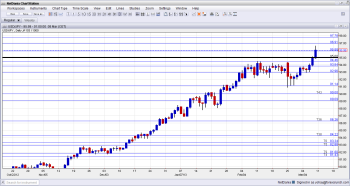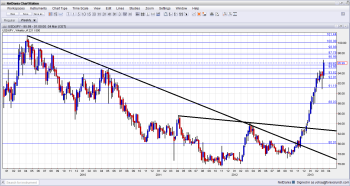USD/JPY was on a roll, finally taking out the 95 line and reaching levels last seen in August 2009. Will we see a continued march towards 100 or a period of consolidation now? Core Machinery Orders , BSI Manufacturing Index and Monetary Policy Meeting Minutes are the highlights of this week. Here’s an outlook for the Japanese events and an updated technical analysis for USD/JPY.
It’s not only the yen’s weakness, but also the US dollar’s strength: the US gained 236K jobs in February, much better than expected. In Japan, the appointment process for the new BOJ governor and 2 other members are continuing as scheduled. Outgoing BOJ Gov. Masaaki Shirakawa noted that Japan’s economy has stopped weakening and is on the right track towards eliminating deflation, however uncertainties remain strong concerning foreign markets economic health. The BOJ’s policy board decided to leave the size of the central bank’s asset-purchase program- at Y101 trillion. Has Japan turned over a new leaf? Let’s Start:
Updates: Core Machinery Orders plunged by 13.1%. The markets had expected a much smaller decline of 1.6%. M2 Money Stock came in at 2.9%, beating the forecast of 2.7%. Preliminary Machine Tools showed improvement, but still posted a steep decline of 21.5%. BSI Manufacturing Index declined 4.6 points. This was better than the estimate of -6.2. The BOJ released its Monetary Policy Meeting Minutes. There were no surprises, as the BOJ maintained its monetary policy at that meeting. Some members stated they were in favor of buying Japanese Government Bonds with longer remaining maturities if additional monetary easing is needed in the future. Tertiary Industry Activity fell 1.1%, lower than the estimate of -0.1%. CGPI declined 0.1%, matching the estimate. Consumer Confidence climbed to 44.3 points, its best showing since August 2007. USD/JPY has edged higher, as the pair was trading at 95.97. Revised Industrial Production was a disappointment, posting a weak gain of 0.3%. This was well below the estimate of 1.0%. USD/JPY has pushed above the 96 line, as the pair was trading at 96.34.
USD/JPY daily chart with support and resistance lines on it. Click to enlarge:
- Core Machinery Orders: Sunday, 23:50. Japan’s core machinery orders gained 2.8% in December, up for a third straight month, following a 3.9% increase in November. The reading beat predictions for a 0.7% decline. The elevated readings indicate that a global economic recovery and a weaker yen encourage companies to spend more. Compared with a year earlier, core orders, fell 3.4% in December. The government raised its assessment of machinery orders. A decline of 1.6% is expected.
- Prelim Machine Tool Orders: Monday, 6:00. Japan’s machine tool orders in January registered a decline of 26.1% on a yearly base, mainly due to lower demand from the part of China and other Asian countries. However industry analysts believe that the recent depreciation of the yen will promote the export enterprises, but investment in equipment recovery will take time.
- BSI Manufacturing Index: Monday, 23:50. Sentiment at big Japanese manufacturers declined sharply in October-December, down to -10.3 from plus 2.5 in the third quarter. However large manufacturers expect sentiment to improve in the first quarter to plus 1.4. An improvement to 6.2 is expected.
- Monetary Policy Meeting Minutes: Monday, 23:50. Japanese Prime Minister Shinzo Abe told Parliament that buying foreign bonds is a legitimate measure to affect stock market. He also noted he may consider revising the BOJ law guaranteeing its independence in case the BOJ will not achieve the target rate of 2% stressing the importance of beating deflation.
- Tertiary Industry Activity: Monday, 23:50. Japan’s service sector activities climbed a seasonally adjusted 1.4% in December, beating market expectations of 0.8% rise and following a 0.4% decline in November. The main gains were in finance, utilities, scientific research, miscellaneous services, real estate and communications. A small drop of 0.1% is forecasted.
- Consumer Confidence: Tuesday, 5:00. Japanese consumer confidence improved in January, reaching 43.3 up from 39.2 in December. This was the first rise in five months, indicating economic recovery is around the corner. The Cabinet Office raised its forecast on the consumer sentiment in light is the recent increase. A small decline to 43.0 is predicted.
- Revised Industrial Production: Thursday, 4:50. Japan’s industrial production increased in December by a seasonally adjusted 2.4%, revised down from a preliminary reading of 2.5%. Transportation, machinery and chemical manufacturers registered gains. A gain of 1.0% is forecasted.
*All times are GMT.
USD/JPY Technical Analysis
$/ ¥ started the week by trading between the 92.95 and 93.84 lines (mentioned last week), in perfect range trading. Later on, it conquered 93.84 and made a nice move to 95. The line gave a fight at first, but it then surrendered and the pair reached 96.58 before closing at 95.99.
Here is a weekly chart, showing the big lines:
- Technical lines from top to bottom
Looking above 100, we find the 101.44 line, which was the post crisis high seen in April 2009. The obvious number below is the very round number of 100.
98.90 capped the pair in June 2009 and serves as minor resistance. A stronger line is the 97.80 line, which was a peak back in 2009. This is the next big target. 96.90, which was a swing high in July 2009, is getting closer now. The pair reached 96.58 in the post-NFP swing, not too far from this line.
95.88 now serves as a pivotal line within the new high range. The round number of 95 was breached, and now works as support.
The previous February 2013 peak of 94.40 should be noted. A second move towards that line in February fell short, but the pair made it in March.
93.84 was an initial peak for the pair as it climbed higher and has served as a cap afterwards. 92.95 was an earlier resistance line, and later served as support.
92.12 was a peak in the past, and provides some support, as seen in February 2013. The line is weaker now. 91.20, which capped the pair very temporarily on its way up in January 2013, is a support line and is now stronger.
The ultimate support line for now is 90 – a target marked by many analysts and a round number. This line remains close after the break. Just below, 89.67 capped the pair for several days in January 2013 and is now minor support.
Below, 89.10 was a peak in the summer of 2010, before the pair began descending and is now support. 88.40 is the peak of January 2013 and is a strong support line.
Another recent technical view: USD/JPY Hits New Long-Term High for Potential Uptrend Continuation – by James Chen
I remain bullish on USD/JPY
The Japanese yen has room to fall until the next BOJ meeting, led by the new governor Kuroda. This is when rhetoric will need to be matched with deeds. At the moment, with an acceleration in the US recovery, the pair could continue higher. Perhaps we will not see such a strong move.
More about the BOJ: Goodbye Mr Shirakawa and a Strong JPY
Further reading:
- For a broad view of all the week’s major events worldwide, read the USD outlook.
- For EUR/USD, check out the Euro to Dollar forecast.
- For GBP/USD (cable), look into the British Pound forecast.
- For the Australian dollar (Aussie), check out the AUD to USD forecast.
- For USD/CAD (loonie), check out the Canadian dollar forecast

